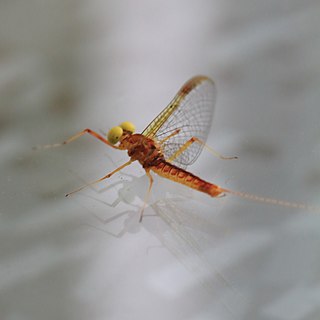
Mayflies are aquatic insects belonging to the order Ephemeroptera. This order is part of an ancient group of insects termed the Palaeoptera, which also contains dragonflies and damselflies. Over 3,000 species of mayfly are known worldwide, grouped into over 400 genera in 42 families.

Baetidae is a family of mayflies with about 1000 described species in 110 genera distributed worldwide. These are among the smallest of mayflies, adults rarely exceeding 10 mm in length excluding the two long slender tails and sometimes much smaller, and members of the family are often referred to as small mayflies or small minnow mayflies. Most species have long oval forewings with very few cross veins but the hindwings are usually very small or even absent. The males often have very large eyes, shaped like turrets above the head.

The Inyo shrew is a species of shrew found in the western United States. It is light gray and white in color, with a narrow skull and small body size, very similar in appearance to the related dwarf shrew, but paler and not as large. It can be found in many different habitats, from rocky, mountainous regions to wetlands and riparian areas. Not much is known about its behavioral and reproductive habits. While barely studied, their population is believed to be stable and not under any threat.

Baetis is a genus of mayflies of the family Baetidae, known as the blue-winged olive to anglers. There are at least 150 described species in Baetis. They are distributed worldwide, with the most variety in North America and northern Europe.

Heptagenia is a genus of flatheaded mayflies in the family Heptageniidae. There are at least 20 described species in Heptagenia.

Rhithrogena is a genus of flatheaded mayflies in the family Heptageniidae. There are at least 150 described species in Rhithrogena.

Stenacron is a genus of mayfly in the family Heptageniidae, with a distribution across eastern North America.
Neoephemera is a genus of large squaregill mayflies in the family Neoephemeridae first described by McDunnough (1925). and containing approximately six described species in Neoephemera.

Baetiscidae is a family of mayflies. It contains a single extant genus, Baetisca, native to North America with around 12 species. The family is noted for their spined armoured larvae, which live in flowing water pools and on the edges of streams where they are detritivores, consuming fine particles of organic matter. Two other extinct genera are known, extending back to the Early Cretaceous. They are closely related to Prosopistomatidae which have unusual, beetle-like nymphs as well as the extinct genus Cretomitarcys, with the three groups constituting the clade Carapacea.
Brachycercus is a genus of small squaregilled mayflies in the family Caenidae. There are at least four described species in Brachycercus.
Leptohyphes is a genus of little stout crawler mayflies in the family Leptohyphidae. There are about 18 described species in Leptohyphes.
Tricorythodes is a genus of little stout crawler mayflies in the family Leptohyphidae. There are about 16 described species in Tricorythodes.
Ametropodidae is a family of mayflies in the order Ephemeroptera. There are at least three genera and three described species in Ametropodidae.
Litobrancha is a genus of common burrower mayflies in the family Ephemeridae. There is at least one described species in Litobrancha, L. recurvata.
Anthopotamus is a genus of hacklegilled burrower mayflies in the family Potamanthidae. There are at least four described species in Anthopotamus.
Anthopotamus distinctus is a species of hacklegilled burrower mayfly in the family Potamanthidae. It is found in southeastern Canada and the eastern United States.
Anthopotamus verticis, or Walker's tusked sprawler, is a species of hacklegilled burrower mayfly in the family Potamanthidae. It is found in southeastern Canada and the northern and southeastern United States.
Anthopotamus neglectus is a species of hacklegilled burrower mayfly in the family Potamanthidae. It is found in southeastern Canada and the northeastern United States.

Pisciforma is a suborder of mayflies in the order Ephemeroptera. There are at least 410 described species in Pisciforma.
Procloeon rubropictum is a species of small minnow mayfly in the family Baetidae. It is found in the south half of Canada and the eastern United States.






